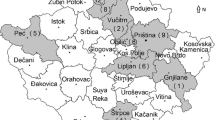Abstract
Radon-prone areas in Israel were mapped on the basis of direct measurements of radon (222Rn) in the soil/rock gas of all exposed geological units, supported by the accumulated knowledge of local stratigraphy and sub-surface geology. Measurements were carried out by a modified alpha-track detection system, resulting in high radon levels mainly in rocks of the Senonian-Paleocene-aged Mount Scopus Group, comprised of chert-bearing marly chalks, rich in phosphorite which acts as the major uranium source. Issues of source depth, seasonal variations and comparison with indoor radon levels are addressed as well. This approach could be applied to other similar terrains, especially the Mediterranean Phosphate Belt.
Similar content being viewed by others
Author information
Authors and Affiliations
Rights and permissions
About this article
Cite this article
M., S., Vulkan, U. Mapping radon-prone areas - a geophysical approach. Environmental Geology 31, 167–173 (1997). https://doi.org/10.1007/s002540050176
Issue Date:
DOI: https://doi.org/10.1007/s002540050176




